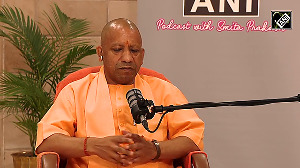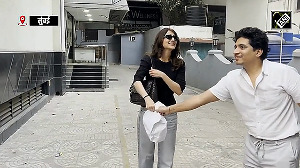 Bearing in mind how full India’s pitcher is with ethnic and communal complexities, only the greatest circumspection can hold this country together in a willing union, says Sunanda K Datta-Ray
Bearing in mind how full India’s pitcher is with ethnic and communal complexities, only the greatest circumspection can hold this country together in a willing union, says Sunanda K Datta-Ray
It isn’t enough for the Bharatiya Janata Party to distance itself -- whatever that means -- from egregious personalities such as the Vishwa Hindu Parishad’s Sadhvi Prachi. They must be firmly suppressed. For it is precisely their kind of bigotry that fans minority nervousness, breathes life into separatist violence as in the north-east and imperils Indian unity.
The fuss over Muslim participation in yoga demonstrations is one aspect of the intolerance towards which we are hurtling. The desecration of churches, “ghar wapsi” campaigns and moves against customs and celebrations regarded as Christian -- like the ill-advised decision regarding Christmas Day -- highlight the same bias. So do attacks in places as far apart as Delhi and Bengaluru on people with distinctive Mongolian features. The combined effect can only force Nagas, Mizos, Meteis, Bodos, Khasis and other north-eastern peoples to exaggerate the ethnic and cultural gulf that separates them from the Hindu-Hindi heartland and conclude there is no place for them in a BJP-ruled Aryavarta.
And not just them. The All India Muslim Personal Law Board has reacted with alarm to what it calls the rising influence of “Brahmin Dharma and Vedic culture... out to harm Islamic beliefs by all means”. Admittedly, the AIMPLB, which displays the psychological hang-ups of a beleaguered minority, is not itself the country’s most flexible organisation. But its general secretary, Maulana Wali Rahmani, would probably not have appealed to Muslim organisations, institutions and imams to close ranks against the forces of Hindutva if there hadn’t been real fears of a drift towards theocratic rigour.
Yoga is a perfectly legitimate physical and mental exercise that enjoys global acceptance. Vande mataram is a stirring patriotic song. Surya namaskar and the Gayatri mantra can be profoundly soothing. But they become obnoxious the moment they are forced down anyone’s throat. True, they represent the culture of the numerical majority but the majority alone doesn’t define India although some majority practices have acquired a national character. No one objects, for instance, to lighting a lamp to inaugurate an event or smashing a coconut to launch a ship although Syed Shahabuddin, the diplomat-politician, argued long ago they were Hindu rituals. Mohammad Hamid Ansari’s namaskars are welcome if the gesture is voluntary.
The least hint of coercion makes uniformity dangerous for a country as diverse as India. Jack Lynch, Ireland’s prime minister in the late 1960s, used to say that someone with a full pitcher on his head had to walk with care. Bearing in mind how full India’s pitcher is with ethnic and communal complexities, and that we are surrounded by countries that are “adversely interested”, only the greatest circumspection can hold this country together in a willing union.
The June 4 ambush in Manipur when the recently formed United National Liberation Front of Western South-East Asia attacked a convoy, killing 20 soldiers and wounding many more, represented a sombre national breakdown at a time when relations with Myanmar where the rebels are based were at their best and India seemed confident of having mastered insurgencies in the north-east.
Obviously, the authorities didn’t correctly gauge regional sentiment. They also failed to realise that the rising tide of conversions among Nagas was not the mischief of foreign missionaries (who had died or been driven out in any case) but a mute rejection of an overtly Hindu India. I wouldn’t be at all surprised if the discovery by many Mizos of a supposed Jewish identity -- they claim descent from one of the lost tribes of Israel -- and their readiness to migrate to Israel are also manifestations of discontent.
Our worried tribes must be wooed and won back even as lawlessness (whether by them or against them) is punished with a firm hand. So must Muslims. Threatening every so often to send them packing to Pakistan is the surest way of promoting a hostile fifth column that sabotages security from within. With minority groups amounting to some 340 million people, there is no alternative in the long run to conciliation that restores confidence in an India that treats all its children fairly.
No one expected a BJP government under Narendra Modi to take direct executive action to force unwilling Indians into the Hindutva straitjacket. The fear always was that he would look the other way while Sangh Parivar bullies encroached bit by bit on our secular liberties. It will be the end of India as we knew it if that fear is being realised today. I don’t say it is, but there are ominous straws in the wind.
Image: Girls practice yoga inside their school in Ahmedabad. Photograph: Amit Dave/Reuters












 © 2025
© 2025